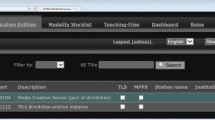Abstract
Customized cancer radiation treatment planning for each patient is very useful for both a patient and a doctor because it provides the ability to deliver higher doses to a more accurately defined tumor and at the same time lower doses to organs at risk and normal tissues. This can be realized by building an accurate planning simulation system to provide better treatment strategies based on each patient’s tomographic data such as CT, MRI, PET, or SPECT. In this study, we develop a real-time online client–server/client collaborative environment between the client (health care professionals or hospitals) and the server/client under a secure network using telematics (the integrated use of telecommunications and medical informatics). The implementation is based on a point-to-point communication scheme between client and server/client following the WYSIWIS (what you see is what I see) paradigm. After uploading the patient tomographic data, the client is able to collaborate with the server/client for treatment planning. Consequently, the level of health care services can be improved, specifically for small radiotherapy clinics in rural/remote-country areas that do not possess much experience or equipment such as a treatment planning simulator. The telematics service of the system can also be used to provide continued medical education in radiotherapy. Moreover, the system is easy to use. A client can use the system if s/he is familiar with the WindowsTM operating system because it is designed and built based on a user-friendly concept. This system does not require the client to continue hardware and software maintenance and updates. These are performed automatically by the server.










Similar content being viewed by others
References
Aird EGA, Conway J (2002) CT simulation for radiotherapy treatment planning. Br J Radiol 75:937–949
Bucci MK, Bevan A, Roach M (2005) Advances in radiation therapy: conventional to 3D, to IMRT, to 4D, and beyond. CA Cancer J Clin 55:171–134
Cai W, Walter S, Karangelis G, Sakas G (2000) Collaborative virtual simulation environment for radiotherapy treatment planning. Eurographics 19(3):1–12
Gilat A (2004) MATLAB: an introduction with applications. Wiley, Indianapolis
Ibanez L, Schroeder W, Ng L, Cates J, the Insight Software Consortium (2005) The ITK software guide, 2nd edn. ITK, Venray
Kang L, Sohn MY, Cheng TCE (2004) Paired-domination in inflated graphs. Theor Comput Sci 320:485–494
Kim HK, Kum O (2006) Development of a parallel electron and photon transport (PMCEPT) II: absorbed dose computation in homogeneous and heterogeneous media. J Kor Phys Soc 49(4):1640–1651
Kum O, Lee S (2005) Development of a parallel electron and photon transport (PMCEPT) I: method and absorbed dose computation in water. J Kor Phys Soc 47(4):716–725
Kum O (2006) Development of web-based customized cancer radiation treatment planning simulation system (abstract). Med Phys 33(6):2086–2087
Kum O (2006) A customized cancer radiation treatment planning simulation system via networks. In: IFMBE proceedings: world congress 2006 on medical physics and biomedical engineering (WC2006), Seoul Korea, pp 2108–2111
Lee EK, Fox T, Crocker I (2000) Optimization of radiosurgery treatment planning via mixed integer programming. Med Phys 27(5):995–1004
Lee EK, Fox T, Crocker I (2003) Integer programming applied to Intensity-Modulated Radiation Therapy treatment planning. Ann Oper Res 119:165–181
Lockwood GJ, Ruggles LE, Miller GH, Halbleib JA (1980) Calorimetric measurement of electron energy deposition in extended media—theory vs experiment. Report no. SAND79-0414, Sandia National Laboratory, USA
Marks LB, Sibley G (1999) The rationale and use of three-dimensional radiation treatment planning for lung cancer. Chest 116(6):539s–545s
MPI Document Group (2004) MPI-2: message passing interface at http://www-unix.mcs.anl.gov/mpi
Nelson WR, Hirayama H, Rogers DWO (1985) The EGS4 code-system, report no. SLAC-265. Stanford Linear Accelerator Center, USA
Ntasis E, Maniatis TA, Nikita KS (2002) Real-time collaborative environment for radiation treatment planning virtual simulation. IEEE Trans Biomed Eng 49(12):1444–1451
Ntasis, Maniatis TA, Nikita KS (2003) Secure environment for real-time tele-collaboration on virtual simulation of radiation treatment planning. Technol Health Care 11:41–52
Philips Medical Systems (2005) Product news (image-guided radiation therapy). RSNA News 15:26–26
Roerdink JBTM, Aeijster A (2001) The watershed transform: definitions, algorithms, and parallelization strategies. Fundam Inform 41:187–228
Rogers DWO, Faddegon BA, Ding GX, Ma CM, We J, Mackie TR (1995) BEAM: a Monte Carlo code to simulate radiotherapy treatment unit. Med Phys 22(5):503–522
Sampau J, Wilderman SJ, Bielajew AF (2000) DPM, a fast, accurate Monte Carlo code optimized for photon and electron radiotherapy treatment planning dose calculation. Phys Med Biol 45:2263–2291
Schneider W, Bortfeld T, Schlegel W (2000) Correlation between CT numbers and tissue parameters needed for Monte Carlo simulations of clinical dose distributions. Phys Med Biol 45:459–478
Sheikh-Bagheri D, Rogers DWO, Ross CK, Seuntjens JP (2000) Comparison of measured and Monte Carlo calculated dose distributions from the NRC linac. Med Phys 27:2256–2266
Shepard DM, Ferris MC, Olivera GH, Mackie TR (1999) Optimizing the delivery of radiation therapy to cancer patients. SIAM Rev 41:721–744
Sterling TL, Salmon J, Becker DJ, Savarese DF (1999) How to build a beowulf. MIT Press, Cambridge
X-5 Monte Carlo team (eds) (2003) MCNP5. Reoprt no. LA-UR-03-1987 Los Alamos National Laboratory, USA
Yang Y, Liu Q (2004) 3D CT simulation and treatment planning system for radiotherapy. In: Proceedings of 2004 international conference on information acquisition (ICIA2004), Hefei, China, pp 436–439
Yoo TS (2004) Insight into Images. A K Peters, Wellesley
Schroeder W, Martin K, Lorensen B (2004) The visualization Toolkit. Kitware, USA
Acknowledgements
We thank Bill Hoover for his careful proofreading and thoughtful comments. This work was supported by the BK21 Information Technology Manpower Development Program of the School of Electrical Engineering and Computer Science at Kyungpook National University.
Author information
Authors and Affiliations
Corresponding author
Rights and permissions
About this article
Cite this article
Kum, O. Telematics-based online client–server/client collaborative environment for radiotherapy planning simulations. Med Bio Eng Comput 45, 1053–1063 (2007). https://doi.org/10.1007/s11517-007-0262-2
Received:
Accepted:
Published:
Issue Date:
DOI: https://doi.org/10.1007/s11517-007-0262-2




